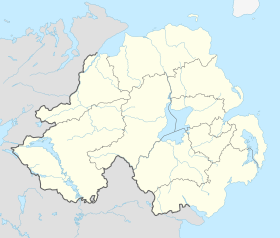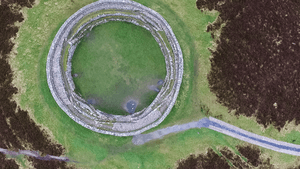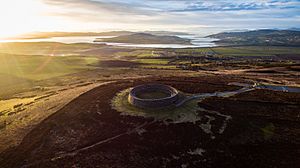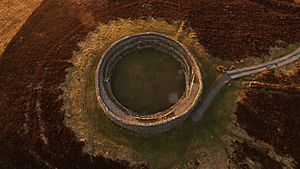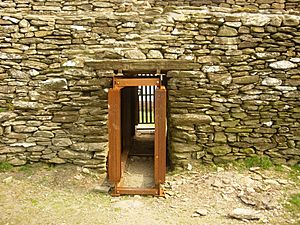Grianan of Aileach facts for kids
|
Irish: Grianán Ailigh
|
|

Grianán of Aileach
|
|
| Alternative name | Greenan Ely |
|---|---|
| Location | County Donegal, Ireland |
| Coordinates | 55°01′26″N 7°25′39″W / 55.0238°N 7.427592°W |
| Type | Ringfort |
| Height | 5 metres (16 ft) |
| History | |
| Material | Stone |
| Founded | 6th century CE or earlier |
| Abandoned | 12th century CE |
| Periods | Iron Age–Middle Ages |
| Cultures | Gaelic |
| Associated with | Kings of Ailech |
| Site notes | |
| Excavation dates | 1830s; 1870s |
| Archaeologists | George Petrie; Walter Bernard |
| Public access | Yes |
The Grianán of Aileach (gree-NƏN-_-ƏV-_-AL-yə(kh); Irish: Grianán Ailigh) is an ancient stone fort in County Donegal, Ireland. It sits on top of Greenan Mountain, which is about 244 metres (801 ft) high. People sometimes call it Greenan Ely or Greenan Fort.
This amazing stone structure is a type of ringfort. Experts believe it was built by the Northern Uí Néill people around the 6th or 7th century CE. However, the site was used even before the fort was built. It was once the main home of the Kings of Ailech and was one of the important royal sites in ancient Ireland.
The fort's wall is very thick, about 4.5 metres (15 ft) wide and 5 metres (16 ft) tall. Inside, it has three levels, connected by steps. There are also two long secret passages within the wall itself. Long ago, there would have been buildings inside the fort. Outside the main fort, you can still see the remains of an old well and a tumulus (an ancient burial mound).
By the 12th century, the Kingdom of Ailech was facing many challenges. It lost land to the invading Normans. Irish stories say that Muirchertach Ua Briain, the King of Munster, mostly destroyed the fort in 1101. A lot of repair work was done in 1870 to bring it back to life. Today, the Grianán of Aileach is an Irish National Monument and a popular place for tourists to visit.
Contents
What is a Hillfort?
The Grianán of Aileach is a special kind of hillfort. It is a stone ringfort that has multiple walls, making it a "multivallate cashel hillfort."
A ringfort is usually a circular area surrounded by a bank and a ditch, or a stone wall. The bank is often made from the earth dug out to create the ditch. Ringforts come in many different sizes and styles. In places like Aileach, the defensive walls take up much more space than the living area inside.
Historians believe that ancient people built circular sites for good reasons. A circular shape allowed them to see all around the area. It also let them enclose the largest possible space with the least amount of wall. Some even think that circular shapes connected the living area to the circular burial mounds of their ancestors. Many Irish hillforts have mounds or cairns (stone piles) inside them, and Aileach is one of them.
Ringforts were home to families, and their size often showed how wealthy the family was. Most ringforts were not built on high, commanding spots. The only exceptions were in wet areas where high ground was the best place to build a home. Some ringforts, like Aileach, might have been built on high ground for better drainage, not just for defense.
Why is Aileach Special?
Hillforts are defined by their location and how they are built. They are large hilltop areas with one or more walls of earth or stone around the top. A famous example is Dún Aengus on Inishmore, which has sharp stone slabs outside its walls for defense.
The Grianán of Aileach has three walls around it, making it a "trivallate" fort. The actual living space inside ringforts was often less than 60% of the total area. Ancient laws said that a king's main home should be a ringfort with one wall. Having more walls, like Aileach's three, showed how important and powerful the people living there were, more than just needing extra defense.
Some experts believe that these large forts were more about showing royal power than being strong defenses. Stone buildings look strong and lasting. The Grianán of Aileach was built on its site for the amazing views, not just for defense. This means its walls were not just for protection, but also to show off the king's power and influence.
Irish hillforts were not as big or complex as those in other parts of Europe. Stone ringforts (called cashels) are usually smaller than those made of earth. The Grianán of Aileach is larger than most cashels in its area. This suggests that its inhabitants were very wealthy and important, and perhaps many people lived there. When it was first built, the stone fort of Aileach must have been a very unusual sight.
When Was it Built?
Most ringforts were built during the Early Christian period in Ireland. Things found at ringforts usually date from the second half of the first millennium (around 500-1000 CE). These include pottery, glass beads, and pins made of bone, bronze, and iron.
During an excavation of the Grianán of Aileach, similar items were found. One expert, Brian Lacy, believes the fort was built around 789 CE. He says that after a big battle in 789, the Cenél nEógain kings gained control of the northern Uí Néill lands. They then moved to the Grianán site and built the stone fort inside an older, prehistoric hillfort. This new fort was a symbol of their power over all the land they could see from that high spot. Most of Ireland's ringforts were built and used between the early 7th century and the late 9th century AD.
The Grianán of Aileach was likely used by the northern Ui Néill kings from 789 until about 1050. Around this time, many local kings in Ireland started moving to towns built by the Vikings or to important church sites that were becoming like towns.
Why Was it Important?
The Grianán of Aileach likely served many purposes, from being a defensive site to a place for special ceremonies. Some old writers even thought it might be one of the "royal places" marked on an ancient map of Ireland. Early texts sometimes called Aileach the oldest building in Ireland.
To understand its purpose, let's look at its name. The Grianán of Aileach has had many names over time, like Aileach, Aileach Neid, and Grianán Ailigh. The word "Aileach" comes from an old Irish word "Ail," meaning "rock" or "stone." So, Aileach likely means "stony place" or "stone house."
The word "Grianán" means "sunny place." In ancient Ireland, it also meant a place with a great view. This is probably why it was used for the Grianán of Aileach, which has amazing panoramic views. Some thought it meant "temple of the sun," but this idea hasn't been proven. The word was often used to mean a special home or palace. So, the full name "Grianán of Aileach" could mean "The Stone Palace of the Sunny View."
From the mid-6th century until the 12th century, the Grianán of Aileach was seen as the capital of the northern Ui Neill dynasty. It was the place where the Kings of Ailech had their special inauguration ceremonies. An old story says that Saint Patrick blessed the fort and left a special stone there, predicting that many kings and church leaders would come from that place. This stone is now believed to be at Belmont House School in Derry. It has two foot marks carved into it.
The Grianán of Aileach was a very important site. It was the main political center of Northwest Donegal, while the church settlement at Derry was the religious center. Together, they formed the heart of the region. The fort's importance meant it was attacked at least three times. In 674, Fínsnechta Fledach, King of Ireland, destroyed it. In 937, Viking raiders attacked it. And in 1101, Muirchertach Ua Briain, another king, destroyed it in revenge for an earlier attack on his own home.
While Aileach was a royal capital, most ringforts in Ireland were simply farmsteads for families. However, hillforts like Aileach were important for entire communities. It's unlikely Aileach was ever just a cattle enclosure, as its entrance is too narrow for animals. This narrow entrance might have been for defense.
What Can We See Today?
The Grianán of Aileach is near the town of Burt. Its main walls and features are still largely in place. Parts of the fort were damaged over time, but much was rebuilt in the 19th century to keep its historic look. Dr. Bernard led this restoration work. Today, the Irish government owns the site.
More restoration work has happened since 2001 because a wall collapsed. You can see signs of this work. Large parts of the wall have been replaced, and these new sections look different in shape and color from the original parts. Some upper parts of the wall have been cemented to stop stones from falling. An iron gate has been put at the entrance.
In Mythology
In Irish mythology and folklore, people say the Grianán of Aileach was first built by the Dagda. He was a god and a famous king of the Tuatha Dé Danann, who fought against the Fomorians. The fort was built around the grave of his son, Aedh, who was killed by a chieftain named Corrgenn.
A long poem in the Book of Lecan tells the story of Aedh's death and the building of Aileach. Here are some verses about how the fort was built:
"Then were brought the two good men
In art experts,
"Garbhan and Imcheall", to Eochaid [Daghda],
The fair-haired, vindictive;
he ordered these a rath to build, Aileach."
Around the gentle youth:
That it should be a rath of splendid sections—
The finest in Erinn.
Neid, son of Indai, said to them,
[He] of the severe mind,
That the best hosts in the world could not erect
A building like Aileach.
Garbhan the active proceeded to dress
And to cut [the stones];
Imcheall proceeded to set them
All around in the house.
The building of Aileach's fastness came to an end,
Though it was a laborious process;
The top of the house of the groaning hostages
"One stone closed".
Another verse in the poem says that Aileach is the oldest or "father" of all buildings in Ireland. It also says that later it was called Aileach Frigrind. According to another old poem, Frigrind was a famous builder who was given the ancient fort of Aileach as his home. Here, Frigrind built a beautiful wooden house for his wife, decorated with gold and bronze and shining gems. These old poems suggest that not only the outer stone walls of Aileach were built of stone, but also the palace and other houses inside.
According to ancient records, Aileach was built 1,700 years before the Christian era. It's also one of the few places in Ireland that was correctly marked on a map by the ancient geographer Ptolemy of Alexandria, who lived in the 2nd century. Ptolemy even noted that Aileach was a royal residence.
Images for kids
See also
 In Spanish: Grianán de Ailech para niños
In Spanish: Grianán de Ailech para niños


